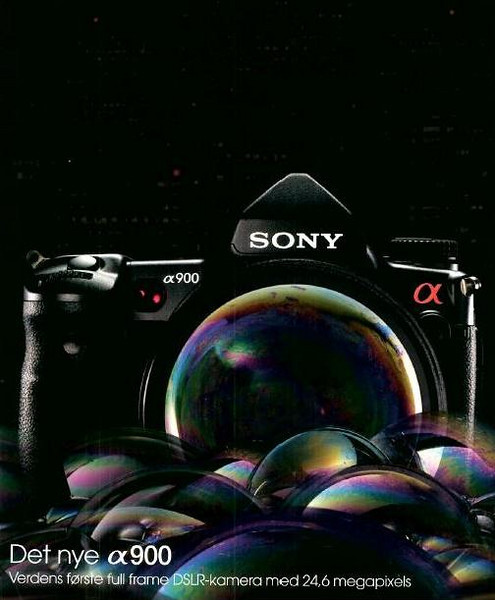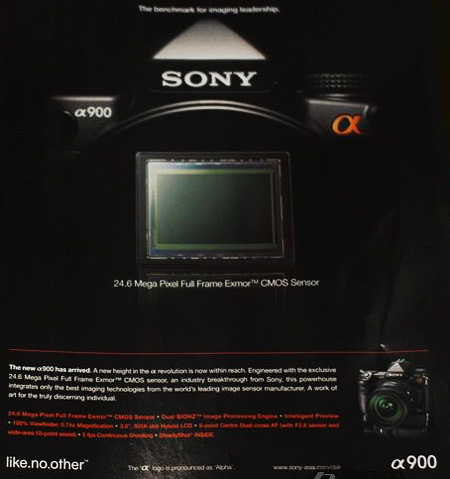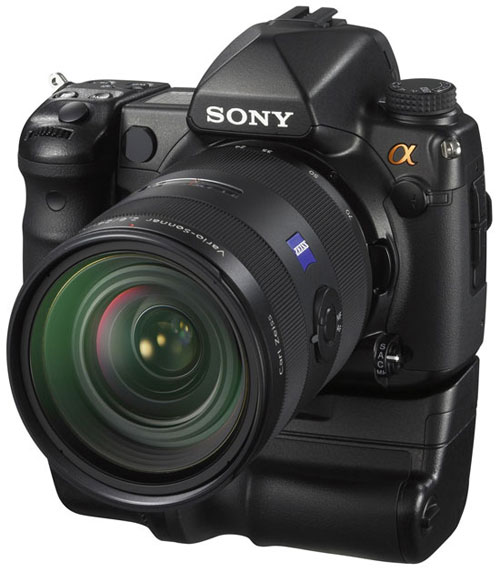Biggest Guns Still Missing from Pre-Photokina Announcements
by Wesley Fink on September 5, 2008 12:00 AM EST- Posted in
- Digital Camera
Sony A900
All evidence now points to an almost certain announcement of the Sony A900 around September 10. Sony has scheduled worldwide events for professional photographers around that date. There have also been leaks of two new ads for the A900 - one from National Geographic in English and a Danish photo magazine ad.

The Danish ad appears legitimate in that it continues the Sony "bubbles" theme that they've used in several other ads this year. The rest of the ad also expands convincingly and provides more details of the A900: 24.6MP Full Frame Exmor CMOS Sensor; Dual Bionz Image Processing Engine; Intelligent Preview; 100% Viewfinder 0.74 mag; 3.0" 921,000 dot hybrid LCD; 9 point dual cross AF (with f2.8 sensor and wide area 10 point assist); 5 FPS; Steady shot. (For those interested, the Danish text at the bottom translates as, "The new A900. The world's first 24.6MP full-frame DSLR camera.")
The description of 9-point dual cross AF with wide area 10-point assist is somewhat confusing. If we were forced to guess, we would speculate the new AF system has 19 points with 9 dual-cross points - the center one being double-cross like the current A700 for f/2.8 or faster lenses - plus 10 outlying single segment AF points. This is certainly an important specification for Sony ads to leave in doubt with such imprecise wording in the ad.

An even more interesting ad has appeared in Asian forums, which claims to be an ad that will appear in the next National Geographic. Several sources have reported this ad and shown captures of the magazine as well as the ad. The text reads as follows:
The new a900 has arrived. A new height in the "α" revolution is now within reach. Engineered with the exclusive 24.6 Mega Pixel Full Frame Exmor CMOS sensor, an industry breakthrough from Sony, this powerhouse integrates only the best imaging technologies from the world's leading image sensor manufacturer. A work of art for the truly discerning individual.
24.6 Mega Pixel Full Frame Exmor CMOS Sensor - Dual BIONZ Image Processing Engine - Intelligent Preview - 100% Viewfinder, 0.74x Magnification - 3.0", 921K-out Hybrid LCD - 9-point Centre Dual-cross AF (with f2.8 sensor and wide-area 10-point assist) - 5 FPS Continuous Shooting - SteadyShot INSIDE

Recent leaked A900 ads, images, and specifications hint that the current A700 battery grip may also fit the A900. Photos also seem to support the rumor that the A900 will not have a built-in flash, which would certainly fit many buyers' opinion that a pop-up flash does not belong on a Pro camera. We thought that argument might be dead when the Nikon D700 featured a pop-up flash that also serves as a wireless flash controller. The Sony system also supports wireless flash and a pop-up could be useful.
The other intriguing specifications are the very pro-grade 100% viewfinder and a sort-of Live View system Sony calls "intelligent Preview". This is apparently some sort of fast depth-of-field and focus check on the LCD screen that is fast enough to be useful on a professional camera - unlike the Live View flavors that have appeared so far. Exactly what it is and how it works will have to wait for the Sony official announcement and the hands-on testing.
An unanswered question for many is how sensitive this 24.6MP sensor can be compared to sensors like the one used in the Nikon D3 and D700, which have a standard range to ISO 6400 and an extended range to ISO 25600. Some quick math shows that a full-frame sensor with the same pixel size and spacing as the 12.3MP Sony A700 and Nikon D300 sensor could be around 28MP. That means the Sony should be more sensitive than the highest ISO 6400 seen in the A700, but probably not at the 25600 of the D3/D700 that is half the resolution of the A900 - all else being the same. Our guess would be perhaps a stop faster at 12800 if we were forced to speculate.
The biggest remaining question for the Sony A900 is the price. Rumors have suggested anything from $1500 to $4000. The best info on price we have yet seen is a French ad listing a price of €2499. The same ad shows the current A700 at €1199, which is very close to the US dollar price. That is often the case with photo equipment, which is generally much more expensive in Europe than in the US. Based on that it would seem reasonable that the A900 will sell somewhere between $2500 and $3000 in the US.
The rumored September 10 launch date certainly fits with the professional photographer special events that Sony has scheduled in many cities around the world for September 9, 10, and 11. The invitations we have seen have not specifically mentioned the new full-frame Sony DSLR, but you don't invite professionals to see a Sony presentation on a new point-and-shoot. Leaks suggest a ship date of September 30.










17 Comments
View All Comments
Visual - Friday, September 5, 2008 - link
Forgive me for not being too excited about the "big guns" that are outside of my price range, and expertise really.I am hoping there will be a successor to the PowerShot S5 instead.
Wesley Fink - Friday, September 5, 2008 - link
We appreciate your comment, but the issue with the S5 IS and G0 is the same that manufacturers are now facing with almost any high-end point-and-shoot camera. For the suggested S5/G9 price range of $349 to $499 you can also buy a Sony A200 with a decent 18-70mm kit lens or a tiny Olympus E-420 with a 14-42mm kit lens.Both are real interchangeable lens SLRs with sensors that are huge compared to the S5 - which means much better low-light shooting and higher quality pictures. The Sony has built-in Image Stabilization and the E-420 has Live View that will be familiar to those who use P&S cameras.
Just $100 more and you will find the tiny Canon XS kit and Nikon D60 kit - both with image stabilized kit lens - and the Olympus E-520 which adds Image Stabilization to the small E-420.
The industry is having a difficult time building upper end Point-and-Shoot cameras that make economic sense today. It is likely that the Olympus Micro four-thirds just announced will bring new point and shoots with larger sensors and capabilities more like current DSLRs with a familiar P&S form factor.
We expect to see new Micro 4/3 models at Photokina. Other manufacturers will be watching to see if it catches on with consumers. If it does you will see more large sensor (and better image quality) P&S models from everyone.
jnmfox - Friday, September 5, 2008 - link
I had a Canon S3, I partly bought it to help my wife get used to the idea of having a little bigger camera for when we eventually upgrade to an SLR. To my dismay she hated how big it was and that is couldn’t fit in her purse/diaper bag. So when it broke a few months ago one of the requirements was it had to be small enough to fit in her purse. We ended up with a Panasonic TZ5. I like the larger LCD, long zoom, and 720p video and she likes it can fit in her purse. She is the one with the kids all day so it was important we got something she was happy with. So while I agree that SLRs are defiantly where things are going and the biggest innovations are happening but I also believe P&S have their place (it would be great if they got a modified SLR sensor like you mentioned).I still plan to upgrade to an SLR but it will have to wait till I find one with the features that I want for the price I want…and when I stop spending money on computer parts and home theater equipment.
strikeback03 - Friday, September 5, 2008 - link
The 4/3 sensors, while the smallest of the dSLR sensors, is still almost 8x the area of the sensor used in the TZ5. Barring a revolution in lens construction, there is no way to make a superzoom camera around a dSLR-class sensor pocketable.I carry a Canon SD800IS everywhere with me. Though it is hacked to record in RAW if needed, I don't try to do things with it I would do with one of my SLR bodies. It is useful because it fits in a carpenter pocket so I can carry it anywhere. And you must have a tiny diaper bag if an S3IS won't fit.
Wesley Fink - Monday, September 8, 2008 - link
The micro 4/3 does away with the mirror box and significantly reduces the lens to film plane distance to 50% of the current 4/3 distance. You will likely be surprised at how small the micro 4/3 can be when the cameras start appearing at Photokina later this month.It is our uderstanding that current 4/3 lenses CAN be mounted on micro 4/3 but that an adapter with a spacer block is needed for mounting. THere will also be smaller Micro 4/3 lenses introduced.
For more info on Micro 4/3 at http://www.olympus-global.com/en/news/2008b/nr0808...">http://www.olympus-global.com/en/news/2008b/nr0808... which also has links to a micro 4/3 Features and Benefits page.
strikeback03 - Tuesday, September 9, 2008 - link
I'm basically expecting 1/2 to 1/3 scale rangefinders. So sure they'll be small and high quality, but I'm doubting they can get an 11x zoom and a body small enough to match the TZ5. The P&S cameras don't have a mirror box to deal with either, and the sensor is far smaller so the glass can be as well.Does Olympus have any tricks up their sleeve to get an optical viewfinder in these? Or will they be stuck with EVF/onscreen?
jnmfox - Friday, September 5, 2008 - link
Just lots and lots of stuff...don't ask me I can never find anything in it.Noya - Friday, September 5, 2008 - link
I have the S4, and while it's a decent camera...it's performance is no where near a D-SLR. I took a couple photography classes back in the day (99-01) and had a 35mm film Canon Rebel SLR and even it took better pictures than the S4 (and any non D-SLR digital camera, I would guess).soydios - Friday, September 5, 2008 - link
last page: Nikon D3X, not D2xchiew - Friday, September 5, 2008 - link
yes, d3x, not d2x